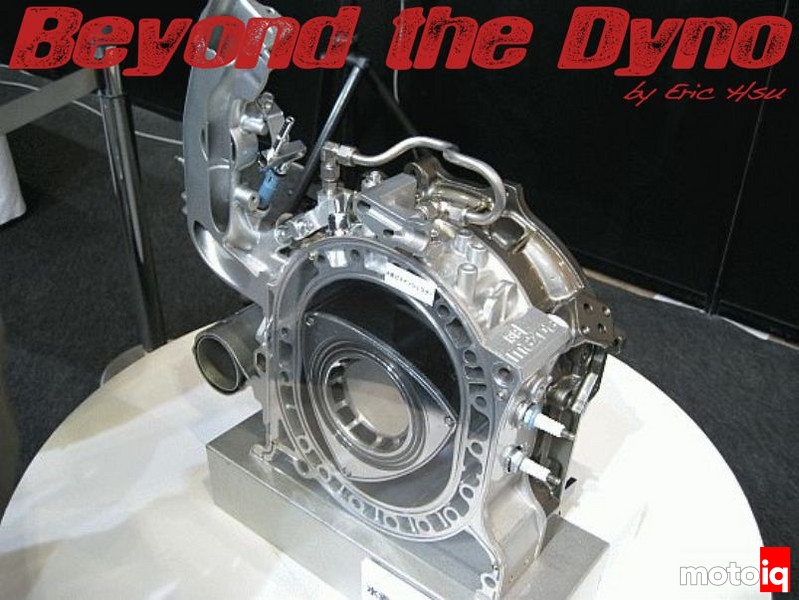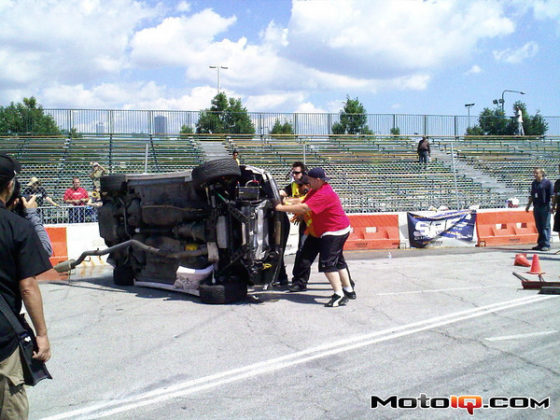
I originally started writing this article back in 2009, but never finished it. I finally got around to it, but some of the info isn't exactly new anymore. Enjoy:
I remember when I was around 14 or 15 years old and the street races were the most exciting thing in the world at the time. Immediately the first cars I became enamored with were the Mazda rotaries. There were a few at Four Lanes in the City of Industry and many more at the Compton/Wilmington races. At Four Lanes in the City of Industry, it was Edwin Mangune in his turbo RX-3 and Frank Choi in his supercharged RX-3 that were the Rotary kings of the time. You may know Edwin from Hawk Brakes or Frank Choi from Battle of the Imports now, but back then they were just kids in their late teens who had fast RX-3s. Whenever either one of them arrived at Four Lanes, everybody stopped and stared. It didn't matter who you were or whether or not you liked rotaries. The sound of their rotaries idling and loping at 1000 rpm was crazy. Their giant intake and exhaust ports coupled with poor air/fuel distribution at low speed from the carburetor(s) and pre-CFD intake manifold designs made the engines sound mean as hell even at idle.
The RX-2s and RX-3s were the only imports that could hang with and sometimes beat the V8s, GNX Grand Nationals, and VW Bugs. What about the old Toyotas and Nissans you ask? The old Japanese piston engines might be nostalgic and pretty cool in their own way, but in the whole scheme of things they were pretty damn slow. Multi-carburetor turbo systems were clumsy and difficult to tune. Ever try tuning a triple Weber turbo Nissan L28? Good luck! The rotary only needed one big carb. It was the Rotary engine that was holding it down for the imports. This was pre-VTEC and pre-fuel injection and the Rotary was the superior Japanese engine at the time.
It was all about Rotary power for me at the time too. I even went and bought a R-100 first and then a RX-7 a little later when I was 15. Neither of them ran: the R-100 needed a fresh engine (the 10A with the 6mm carbon apex seals was dead) and the RX-7 was a theft recovery so it was basically a shell. I already had visions of grandeur even before I had my license and was trying to take on project cars even before I knew how to build them. I never finished either car: the R-100 was parked on the street and got hit in a hit and run and subsequently towed away by the city. I had to sell the RX-7 because it was taking up space in my buddy Will's garage. There were many more Rotary powered vehicles to come later in life, but more on those another day.
When I was 15 years old (circa 1988), my buddy Will bought a used dark Midnight Blue 1979 RX-7 SA22C with a street ported 6 port 13B, a single Dellorto 48 side draft carb, Racing Beat headers with dual exhaust, chrome 15×7.5″ Epsilon 3 piece wheels and a direct port nitrous system. Let's not forget about the dual vertical Sonic Turbo mufflers which was the Rotary trademark of the time. I was to find out later that 6 port engines did not flow as well as ported 4 port engines, but anything's pretty buff when you're 15 and don't know jack shit. This was my first experience with a RUNNING rotary. Will bought the car before he knew how to drive a manual so I had to drive it home for him. It was the very first time I physically drove a manual car and I was surprised how easy it was. It probably helped that I read up on how a clutch system worked like 20 times the night before. I was already familiar with driving cars having been sneaking out my dad's Z31 300ZX shortly after turning 14. You do all kinds of stupid shit when you're young…

Here's a sample of 15″ chrome Epsilon wheels on a SA RX-7. This is not Will's car.
Anyhow, Will didn't really know much about cars. He just liked cars. He was cool enough to let me work on his car though. I guess I had a good track record. My friends and I all used to be into road bikes before we got into cars and I did all the work and mods on his Centurion. At this point I didn't have much experience with cars, but having read a lot of books written by professionals (beats the shit out of the forums of today) and a basic understanding of engines, drivetrains, and air/fuel delivery, I knew far more than Will did. I was also doing slave labor (polish this, sweep that, clean this, etc.) at my uncle Norman's European (Benz, BMW, and Porsche) shop so I saw a lot of cool cars getting built, but he would never let me touch the cool stuff. Will and I brought the RX-7 over to my uncle's shop and I asked him what he thought of the car. The RX-7 seemed a little sluggish up top to me. It seemed to stop pulling around 7000 rpm and I thought a ported rotary engine was supposed rev forever. I asked my uncle what he thought and after driving it around the block he thought it might have been a bit lean. In his words (he grew up in Watts/South Central LA so you'll have to imagine a Chinese dude with a black accent) he said something like, “You call this fast? Foo, this shit is slow! Get in this Porsche and jump on it [he was pointing to a beautiful all steel metallic burgundy slant nose wide body 911 turbo owned by some Indonesian royalty dude] and look in the rear view. You'll see two wide ass [it had 16×13″ BBS RS 3 piece wheels with GIANT Pirelli P7s on it] black marks if you jump on it in any gear. I ain't too familiar with rice burners, but it might need some bigger jets and fresh plugs. Off idle it's a bit lazy too.” My uncle was an old school street racer too, but he raced Mustangs and BMW 2002s in his day. I just told him, “Wait until you hit the nitrous, dude. We'll run that Porsche.” He laughed his ass off of course.
I was totally into reading about everything at the time and had already read the Rotary Bible of the era which was the Racing Beat catalog and another Mazda Rotary racing engine book that featured a lot of info from Roger Mandeville. I cannot remember the title or author but it was a good book so I'll have to dig it up and share one of these days. Neither of these books talked much about carb tuning, but I had already read a different book about rebuilding and tuning Weber and Dellorto carbs so I had a basic understanding of how carbs worked. So heeding my uncle's advice and using what I learned in the book, I bought a cheap ass tool to sync the carb, changed the main jets to a couple of increments larger, fresh cap and rotor on the distributor, new Ultra spark plug wires, adjusted the timing, and got some fresh NGK B9EVs. MAN did the fucker wake up. I'm sure Will's fuel mileage ate shit, but the car started to lay down black marks of its own in 1st and 2nd gear (without the nitrous). That same night Will and I took the car out for a test drive after the work and we were ripping it down one of those roads that ran along the freeway and was separated by a 16' tall brick sound wall to keep the noise away from the residential areas. It was that night that I fell in love with the Rotary. I was able to spin the engine to 8000rpm for the first time and I realized that it didn't want to stop pulling. The exhaust was blasting off the sound wall so we got the audible enjoyment of the exhaust also. I only shifted at 8,000 because the old school Rotary car redline buzzer came on at 7,000rpm and it just freaked you out. It just kept going, “BEEEEEEEEEEEEEP!!!!!!!!!” After getting comfortable with the power, I remember shifting at 8500rpm. The sound of a normally aspirated rotary exhaust screaming at 8500 rpm, the Dellorto making mad intake noise, the oil and fuel smell of an old car, and the rotary car redline buzzer kept Will and I entertained for hours that night. We just kept blasting everywhere. I'm surprised we didn't get chased down by cops and arrested that night. It was pretty stupid for a 15 year old without a license, but it would have been worth it even if I got caught. The carb jet change wasn't rocket science, but it was really cool to see something you learned from a book work in action especially when you're 15 and don't really know WTF you're doing.
Here's an example of the rotary car rev limit buzzer. Imagine that noise the entire time you're above 7000 rpm.
Unfortunately, two months later Will put the car into a wall and totalled it before we ever got to use the nitrous. He replaced the RX-7 with a BMW 850i so that was it for Will and Mazdas, but it was REALLY fun while it lasted. I will always have a soft spot for the Mazda rotary. My crew and I built A LOT of FDs at XS back in the day and I enjoyed turbo rotaries even more. So whenever I see news from Mazda about the Rotary engine, I am glad to see that there is continuing development with the Rotary. Mazda didn't do too great in my opinion with the Renesis 13B since it is heavy, has a relatively low power output, and is fragile when turbocharged, but Mazda is promising better rotaries in the near future.


